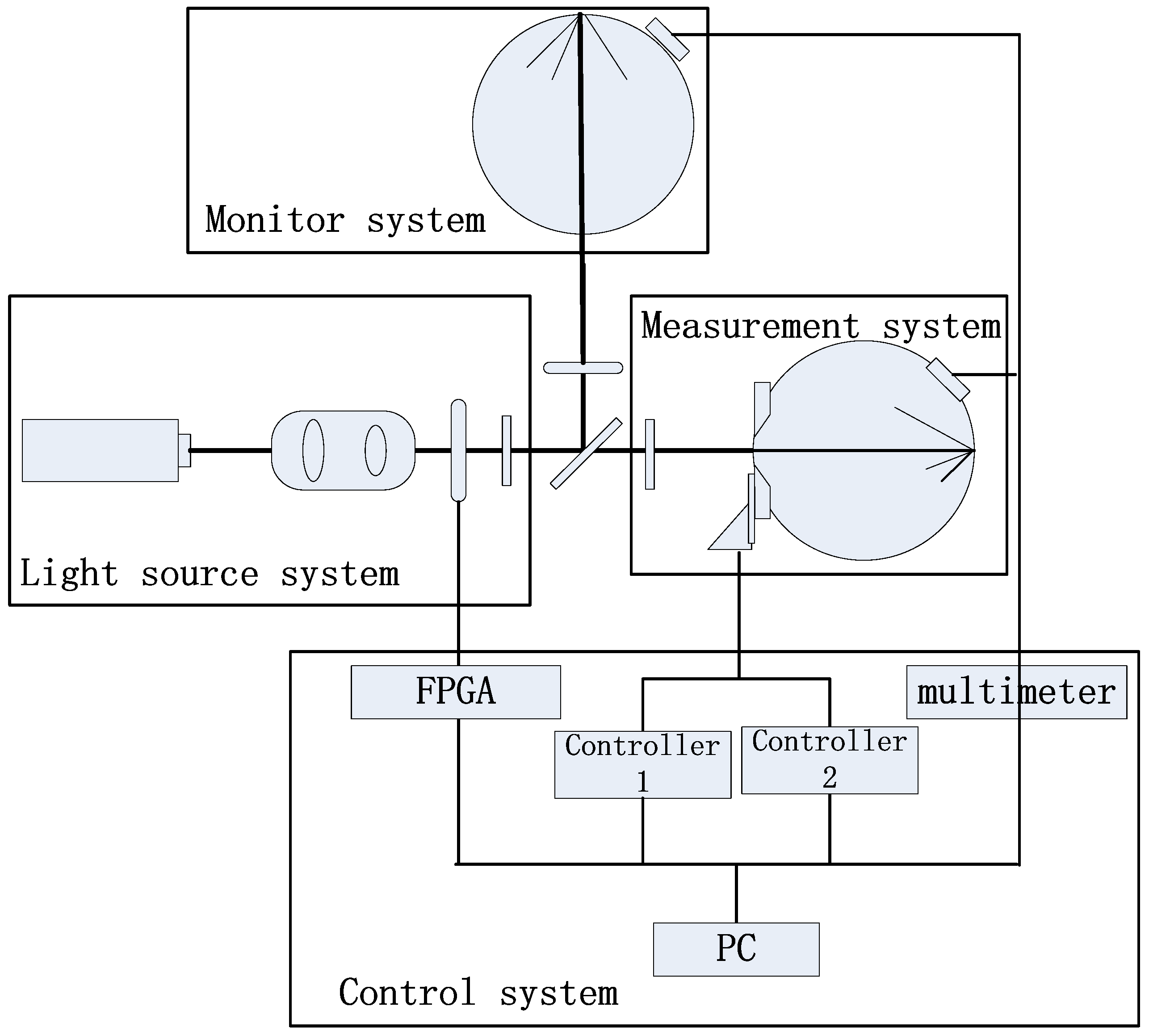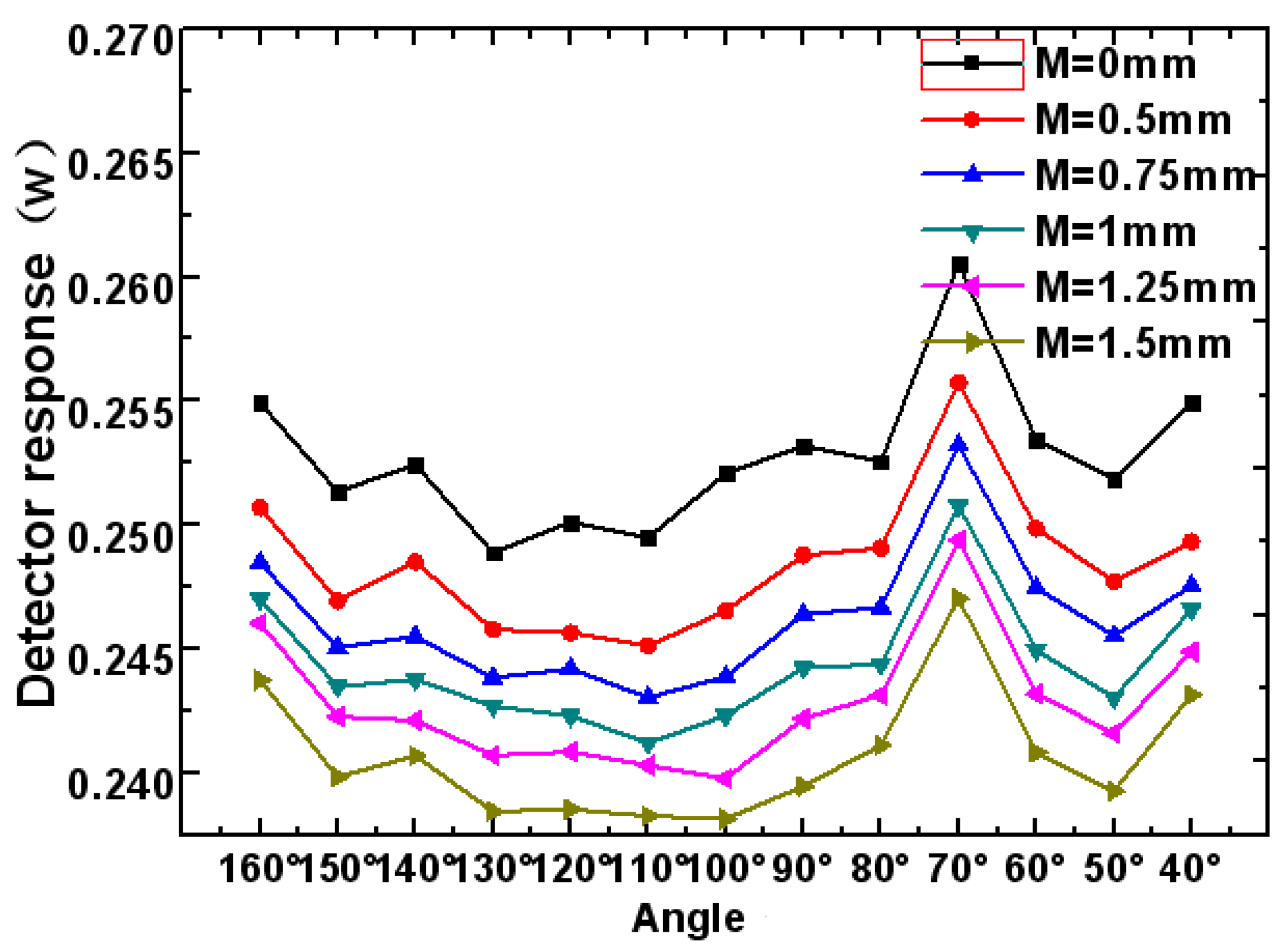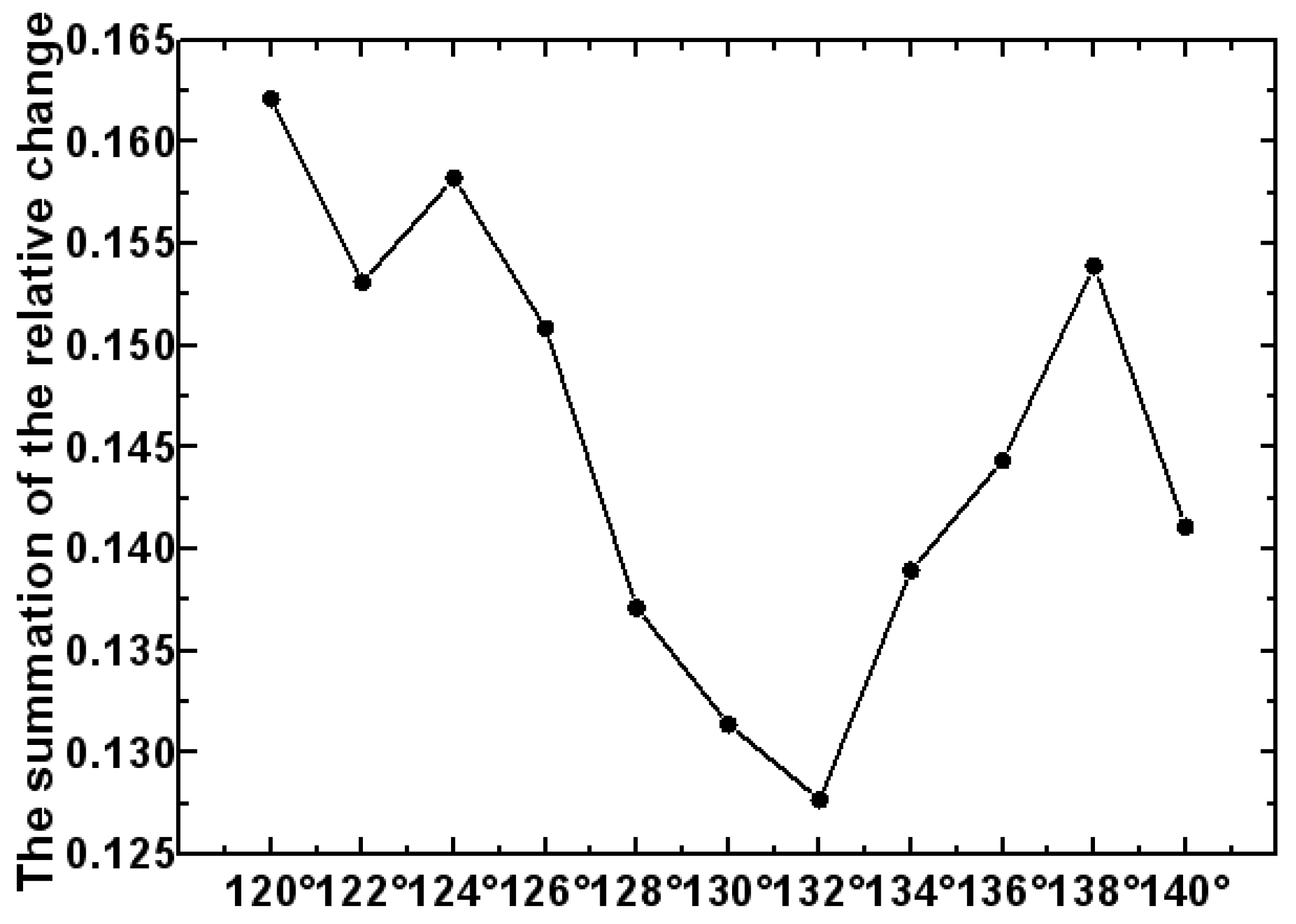Structural Design and Verification of an Effective-Area Measurement Device Detection System
Abstract
:1. Introduction
2. Measurement Principle and Measurement Device of the Effective-Area Method
2.1. Measurement Principle
2.2. Measurement Devices
- (1)
- The light source system is composed of a He-Ne laser, space filter, power stabilizer, iris blade, switch, beam separator, etc. The laser beam becomes a clean and stable Gaussian beam after passing through a spatial filter and a power stabilizer. The radiation power of the Gaussian beam is about 2 mw, and the long-term stability of the beam power is about 3.0 × 10−5 mw. The beam passes through the beam separator and becomes two light beams: one beam of light incident to the monitor system is called the reference-light, another incident to the measurement system is called the measurement-light. To ensure the stability of the light source output beam, an anti-stray diaphragm is added to eliminate the stray light which is brought by the surrounding environment and other factors.
- (2)
- The monitor system is composed of an iris blade and an integrating sphere detector. It is used to monitor the stability of the Gaussian beam in the light source system. The monitoring system is applied to monitor the stability of the laser output Gaussian beam and provide monitoring data for the later data processing in the measurement process of measuring the area of the main diaphragm. The reference-light incident enters the integrating sphere detector and is converted into an electrical signal by a photodiode detector, which is measured with a multimeter device.
- (3)
- The measurement system is composed of a two-dimensional translation stage, an integrating sphere detector, and an iris blade. It is used to measure the area of the aperture. The aperture is mounted on the translation stage, moving at fixed steps ∆x and ∆y in a plane perpendicular to the direction of Gaussian beam propagation. The measurement-light incident enters the integrating sphere detector through the entrance and is converted into an electrical signal by a photodiode detector, which is measured with a multimeter device. During the measurement process, a mirror is temporarily attached to the back of the measured main stop for adjusting the propagation direction of the measured beam to be perpendicular to the plane where the measured main stop is located. After the light path is adjusted, the plane mirror is removed.
- (4)
- The control system is used to control the closing of the switch, control the motion of the two-dimensional precision electronic translation platform, and control the acquisition of radiation flux data from the detector in the measurement system and monitoring system. The control system makes each sub-system cooperate, realizes the measurement and recoding of the data, and finally completes the whole experimental measurement process. The program of the control system is written with the software of LabVIEW. The whole experiment adopts a fully automatic operation mode without human intervention.
3. Structural Model Design of the Detection System
3.1. Structure Model of the Measurement System
3.2. Structure Model of the Detection System
4. Analysis of Simulation Results of Detection System
- (1)
- Light tracing in TracePro software was used to record the response value of the detector to the measurement-light under different integrating sphere detection simulation models. The detector response data curve of each different detection system is shown in Figure 5.
- (2)
- When the distance between the measured aperture and the integrating sphere entrance is 0 mm (that is, M = 0 mm), the measurement system is the reference measurement system. And the corresponding detector response values of the different detection systems are the reference standards. According to Formula (1), the relative changes in the detector response values of all the different detection systems are found.
- (3)
- According to Formula (2), the sum of the relative change in the response values under each detection system can be obtained. As shown in Figure 6, the position A of the detector with the minimum sum value is found, where the value is 130°.
- (4)
- Due to the values remaining continuous and not changing drastically, we first find the minimum range in Figure 6. Then, we narrow down the scope in Figure 7. Ten different detector positions j are redesigned to the left and right of position A. Each position is 2 degrees apart. Sixty integrating sphere detection simulation models are re-established. We repeat the above steps of (1), (2) and (3), and the responses of all the detection systems to the measurement-light can be obtained. The position B of the detector with the minimum sum value of the detector response is found, as shown in Figure 7, and the detector is at the position of 132°. Then, the optimal structure design of the detection system is determined.
5. Experimental Test
6. Discussion
7. Conclusions
Author Contributions
Funding
Institutional Review Board Statement
Informed Consent Statement
Data Availability Statement
Acknowledgments
Conflicts of Interest
References
- Wang, H.; Fang, W. Solar irradiance absolute radiometer with ability of automatic solar tracking. Chin. Opt. 2011, 4, 252–258. [Google Scholar]
- Thuillier, G.; Zhu, P.; Snow, M.; Zhang, P.; Ye, X. Characteristics of solar-irradiance spectra from measurements, modeling, and theoretical approach. Light Sci. Appl. 2022, 11, 79. [Google Scholar] [CrossRef] [PubMed]
- Fang, W.; Yu, B.; Wang, Y.; Gong, C.; Yang, D.; Ye, X. Solar irradiance absolute radiometers and solar irradiancemeasurement on spacecraft. Chin. J. Opt. Appl. Opt. 2009, 2, 23–28. (In Chinese) [Google Scholar]
- Chenghu, G.; Wei, F. Software design and implementation for solar irradiance monitor on FY-3A satellite. Opt. Precis. Eng. 2010, 18, 1476–1482. [Google Scholar]
- Wei, F.; Bingxi, Y.; Haishun, Y. Solar irradiance absolute radiometer and international comparison. Acta Opt. Sin. 2003, 23, 112–116. [Google Scholar]
- Song, B.; Xin, Y.; Yang, D. Precise measurement of voltages in space cryogenic radiation temperature system. Opt. Precis. Eng. 2015, 23, 1903–1910. [Google Scholar] [CrossRef]
- Chen, X.Z.; Fang, W. An overview of the method of high-precision measuring the aperture diaphragn area. Acta Phys. Sin. 2013, 62, 164211. [Google Scholar] [CrossRef]
- Lassila, A.; Toivanen, P.; Ikonen, E. An optical method for direct determination of the radiometric aperture area at high-accuracy. Meas. Sci. Technol. 1997, 8, 973–977. [Google Scholar] [CrossRef]
- Shimizu, Y.; Matsukuma, H.; Gao, W. Optical Sensors for Multi-Axis Angle and Displacement Measurement Using Grating Reflectors. Sensors 2019, 19, 5289. [Google Scholar] [CrossRef] [PubMed]
- Ferrara, C.; Puletti, N.; Guasti, M.; Scotti, R. Mapping Understory Vegetation Density in Mediterranean Forests: Insights from Airborne and Terrestrial Laser Scanning Integration. Sensors 2023, 23, 511. [Google Scholar] [CrossRef] [PubMed]
- Hartmann, J. Advanced comparator method for measuring ultra-small aperture areas. Meas. Sci. Technol. 2001, 12, 1678–1682. [Google Scholar] [CrossRef]
- Ghazi, B.A.; Razet, A.; Bastie, J. Radiometric reference for weak radiations: Comparison of method. Metrologia 2005, 42, 271–277. [Google Scholar] [CrossRef]
- Litorja, M.; Johnson, B.C.; Fowler, J. Area measurements of apertures for exo-atmospheric solar irradiance for JPL. Proc. SPIE 2007, 6677, 667708. [Google Scholar]
- Fowler, J.B.; Durvasula, R.S.; Parr, A.C. High-accuracy aperture-area measurement facilities at the national Institute of Standards and Technology. Metrologia 1998, 35, 497–500. [Google Scholar] [CrossRef]
- Fowler, J.; Litorja, M. Geometric area measurements of circular apertures for radiometry at NIST. Metrologia 2003, 40, S9–S12. [Google Scholar] [CrossRef]
- Stock, M.; Goebel, R. Practical aspects of aperture-area measurements by superposition of Gaussian laser beam. Metrologia 2000, 37, 633–636. [Google Scholar] [CrossRef]
- Ikonen, E.; Toivanen, P.; Lassila, A. A new optical method for high-accuracy determination of aperture area. Metrologia 1998, 35, 369–372. [Google Scholar] [CrossRef]







| No. | Measured Value (mm2) | No. | Measured Value (mm2) |
|---|---|---|---|
| 1 | 21.1280 | 5 | 21.1268 |
| 2 | 21.1321 | 6 | 21.1262 |
| 3 | 21.1331 | 7 | 21.1221 |
| 4 | 21.1307 | ||
| RMS (mm2) | 21.1284 | ||
| Standard deviation (mm2) | 0.0038 | ||
Disclaimer/Publisher’s Note: The statements, opinions and data contained in all publications are solely those of the individual author(s) and contributor(s) and not of MDPI and/or the editor(s). MDPI and/or the editor(s) disclaim responsibility for any injury to people or property resulting from any ideas, methods, instructions or products referred to in the content. |
© 2023 by the authors. Licensee MDPI, Basel, Switzerland. This article is an open access article distributed under the terms and conditions of the Creative Commons Attribution (CC BY) license (https://creativecommons.org/licenses/by/4.0/).
Share and Cite
Chen, X.; Yun, Z.; You, T.; Quan, X. Structural Design and Verification of an Effective-Area Measurement Device Detection System. Sensors 2023, 23, 8215. https://doi.org/10.3390/s23198215
Chen X, Yun Z, You T, Quan X. Structural Design and Verification of an Effective-Area Measurement Device Detection System. Sensors. 2023; 23(19):8215. https://doi.org/10.3390/s23198215
Chicago/Turabian StyleChen, Xiangzi, Ziping Yun, Ting You, and Xiangqian Quan. 2023. "Structural Design and Verification of an Effective-Area Measurement Device Detection System" Sensors 23, no. 19: 8215. https://doi.org/10.3390/s23198215




